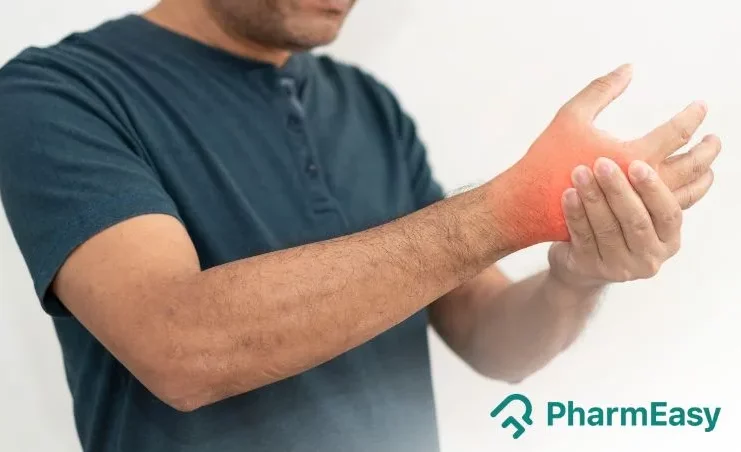Guillain-Barré Syndrome (GBS): Symptoms, Risks & Prevention
By Dr. Nikita Toshi +2 more

Get,

to manage your symptom
Get your,


4 Cr+ families
benefitted

OTP sent to 9988776655



You’ve successfully subscribed to receive
doctor-approved tips on
Whatsapp

Get ready to feel your best.

Hi There,
Download the PharmEasy App now!!


Register to Avail the Offer
Send OTPBy continuing, you agree with our Privacy Policy and Terms and Conditions

Hi There,
Sign up on PharmEasy now!!
Trusted by 4 crore+ families

OTP sent to 9988776655



You have unlocked 25% off on medicines




Code: NU25
By Dr. Nikita Toshi +2 more
Guillain-Barré Syndrome (GBS) is an uncommon (neurological) nerve disorder where the immune system wrongly targets the peripheral nerves, resulting in muscle weakness and, in serious instances, paralysis and death. Recently, Pune in India has seen an increase in GBS cases. A lot of these cases have been linked to infections from the bacterium Campylobacter jejuni. Is this a cause of concern? What we need is awareness. This situation highlights the urgent need for early diagnosis and preventive actions to lessen the effects of this condition.
Table of Contents
GBS is an immune-mediated neuropathy. In this condition, the immune system mistakenly targets the peripheral nervous system—the network of nerves located outside the brain and spinal cord. This misguided immune response due to molecular mimicry damages the myelin sheath, the protective covering of nerve fibers. This interferes with the nerve signal transmission. The result is muscle weakness that typically starts in the lower limbs and can ascend to affect the upper body and facial muscles. In severe cases, GBS can cause complete paralysis and respiratory failure, necessitating mechanical ventilation. If not managed promptly, it may lead to death[1].

While the exact cause of GBS remains unknown[2], it is often preceded by certain infections or medical events that trigger an abnormal immune response:
GBS symptoms[2] can range from mild weakness to complete paralysis, and early recognition is essential for prompt medical intervention.
These symptoms typically last a few weeks, with most individuals recovering without long-term severe neurological complications. However, in approximately one-third of cases, the chest muscles are affected, making breathing difficult. The ability to speak and swallow may also become impaired in severe cases, necessitating intensive care.
Diagnosing GBS involves a combination of clinical evaluation and diagnostic tests:
Early recognition and diagnosis are crucial for initiating appropriate treatment and improving outcomes. One should not wait for the symptoms to worsen because the progression of symptoms is very fast. Consult a neurologist or nearest hospital at the earliest if you develop any of the signs mentioned above.
Immediate hospitalisation is essential for individuals diagnosed with GBS to monitor and manage potential complications:
Most individuals recover fully from even the most severe cases of GBS, although some may continue to experience weakness. In rare instances, complications such as paralysis of the muscles that control breathing can be life-threatening.
In early 2025, Pune experienced a notable increase in GBS cases, with reports indicating over 300 cases linked to Campylobacter jejuni infections. This is not just limited to Pune; other cities of Maharashra like Mumbai and nearby areas also reported GBS cases. Andhra Pradesh, Tamil Nadu and a few other states also detected GBS cases after Pune. This surge has raised concerns among health authorities about a potential outbreak of C. jejuni infections, which usually presents as a stomach infection causing diarrhoea, vomiting and abdominal cramps. Investigations suggest that contaminated food and water sources, particularly undercooked poultry, may be the primary vectors for this bacterium.
Preventing Campylobacter infection[3] is pivotal in reducing the risk of developing GBS. Key preventive measures include:
Here’s a 60-second short video summarizing the essential information on GBS
The recent surge in GBS cases in Pune and other states of India shows the need for increased awareness and early detection. Since Campylobacter jejuni infection is a leading trigger of GBS, you need to follow safe food handling and proper hygiene and ensure clean drinking water, as these are critical in reducing risks. Choosing home-cooked meals and avoiding contaminated food sources can play a key role in prevention. Early medical intervention remains crucial for improving patient outcomes and minimising long-term complications.
Ans. Early symptoms of GBS include tingling sensations, numbness, and weakness starting in the feet and legs. Some individuals may experience back pain, unsteady walking, or difficulty with coordination. If these symptoms progress rapidly, medical attention is crucial.
Ans. No, GBS is not contagious. It is an autoimmune disorder that often follows an infection but does not spread from person to person.
Ans. Recovery varies by individual. Most people see improvement within a few weeks to months, while some may take a year or longer to regain full strength. Physical therapy is often required to restore mobility and muscle function. Immediate hospitalisation is important.
Ans. While GBS itself cannot be entirely prevented, reducing the risk of infections,especially from Campylobacter jejuni (as in present scenario in India) can help lower the chances of developing the syndrome. Practicing good hygiene, safe food handling, and drinking clean water are effective preventive measures.
Ans. If you experience sudden weakness, difficulty walking, or tingling sensations spreading upwards, seek immediate medical attention. Early diagnosis and treatment in a hospital are crucial for better recovery and preventing severe complications.
Disclaimer: The information provided here is for educational/awareness purposes only and is not intended to be a substitute for medical treatment by a healthcare professional and should not be relied upon to diagnose or treat any medical condition. The reader should consult a registered medical practitioner to determine the appropriateness of the information and before consuming any medication. PharmEasy does not provide any guarantee or warranty (express or implied) regarding the accuracy, adequacy, completeness, legality, reliability or usefulness of the information; and disclaims any liability arising thereof.

Leave your comment...
Comments